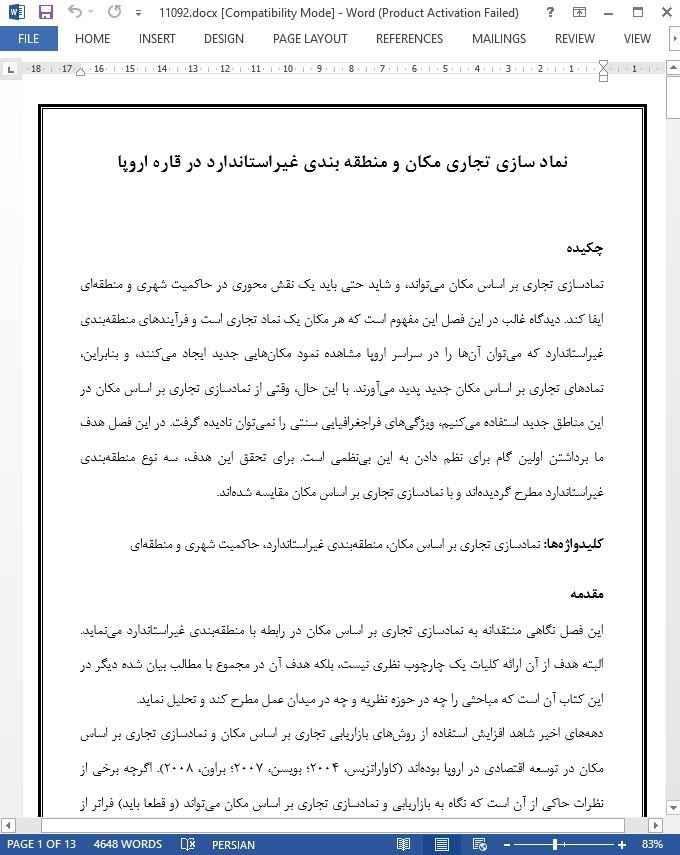
نماد سازی تجاری مکان و منطقه بندی غیراستاندارد در قاره اروپا
چکیده
نمادسازی تجاری بر اساس مکان میتواند، و شاید حتی باید یک نقش محوری در حاکمیت شهری و منطقهای ایفا کند. دیدگاه غالب در این فصل این مفهوم است که هر مکان یک نماد تجاری است و فرآیندهای منطقهبندی غیراستاندارد که میتوان آنها را در سراسر اروپا مشاهده نمود مکانهایی جدید ایجاد میکنند، و بنابراین، نمادهای تجاری بر اساس مکان جدید پدید میآورند. با این حال، وقتی از نمادسازی تجاری بر اساس مکان در این مناطق جدید استفاده میکنیم، ویژگیهای فراجغرافیایی سنتی را نمیتوان نادیده گرفت. در این فصل هدف ما برداشتن اولین گام برای نظم دادن به این بینظمی است. برای تحقق این هدف، سه نوع منطقهبندی غیراستاندارد مطرح گردیدهاند و با نمادسازی تجاری بر اساس مکان مقایسه شدهاند.
مقدمه
این فصل نگاهی منتقدانه به نمادسازی تجاری بر اساس مکان در رابطه با منطقهبندی غیراستاندارد مینماید. البته هدف از آن ارائه کلیات یک چارچوب نظری نیست، بلکه هدف آن در مجموع با مطالب بیان شده دیگر در این کتاب آن است که مباحثی را چه در حوزه نظریه و چه در میدان عمل مطرح کند و تحلیل نماید.
دهههای اخیر شاهد افزایش استفاده از روشهای بازاریابی تجاری بر اساس مکان و نمادسازی تجاری بر اساس مکان در توسعه اقتصادی در اروپا بودهاند (کاواراتزیس، 2004؛ بویسن، 2007؛ براون، 2008). اگرچه برخی از نظرات حاکی از آن است که نگاه به بازاریابی و نمادسازی تجاری بر اساس مکان میتواند (و قطعا باید) فراتر از دیدگاه سنتی به مزیت رقابتی باشد (کالاندیدس، 2012)، نظریه خطمشی اقتصادی نئولیبرال، تفکر راهبردی و اقدامات خطمشی را در راستای پارادایم مزیت رقابتی قرار میدهد که در دستور کار مقامات محلی و منطقهای قرار دارد. در عین حال، مشاهده میشود که منطقهبندیهای غیراستاندارد در اروپا ظهور یافته است. بسیاری از این منطقههای ”جدید“ اقدام به کاری مینمایند که اصطلاحا نمادسازی تجاری بر اساس مکان نام دارد.
نتیجهگیری
نمادسازی تجاری بر اساس مکان یکی از ابزارهای رایجی است که توسط مناطق جغرافیایی جدید و قدیمی برای شناساندن خود به کار میرود. اگرچه اشتباهات بسیاری در استفاده از واژگان مرتبط با این موضوع وجود دارد، برخی اتفاق آراء نظامیافته در این رابطه در حال شکلگیری است. همچنین به نظر نمیرسد در آینده نزدیک از محبوبیت نمادسازی تجاری بر اساس مکان و ابزارهای مرتبط با آن (تبلیغات تجاری و بازاریابی بر اساس مکان) کاسته شود. پارادایم مزیت رقابتی و فرآیندهای تقسیمبندی مجدد شهرها و کارآفرینیگرایی بدان معناست که مکانهای بیشتری خود را وارد عرصه بازارهای در حال توسعه و فرامنطقهای میکنند. مکان ها ”جدید“ تکههای سفید کاغذ نیستند که بتوان آنها را ”وارد بازار“ نمود یا بدون زمینه جغرافیایی آنها برایشان”نماد تجاری ساخت“.
Abstract
Place branding might, could, and maybe even should play a central role in urban and regional governance. The vantage point of this chapter is that every place is a brand and that the processes of nonstandard regionalization that can be witnessed all over Europe create new places and, thus, new place brands. When employing place branding to these new types of regions, however, the traditional meta-geographies cannot be ignored. In this chapter, the aim is to take a first step to bring some order into the chaos. To this end, three categories of nonstandard regionalization are proposed and compared concerning place branding.
Introduction
This chapter offers a critical view of place branding in relation to nonstandard regionalization. It is not meant to be the outline of a theoretical framework, but together with the rest of the contributions in this book, it aims to set out some lines of thought for both theory and practice.
The recent decades have seen a strong increase in the implementation of place marketing and place branding instruments in relation to economic development in Europe (Kavaratzis 2004; Boisen 2007; Braun 2008). Although some voices have been heard proposing that place marketing and place branding can be (and, arguably, should be) viewed outside of the traditional focus on competitiveness (Kalandides 2012), the neoliberal economic policy doctrine places strategic thinking and policy action in line with the competitiveness paradigm firmly on the agenda of local and regional authorities. At the same time, various developments have seen a rise of nonstandard regionalization in Europe. Many of these “new” regions engage in socalled place branding.
Concluding Remarks
Place branding is becoming a commonly used instrument for both old and new regions to assert themselves. Although there is a lot of terminological confusion at work, the beginnings of some disciplinary consensus are emerging. The popularity of place branding and kindred instruments (place promotion, place marketing) is not likely to decline anytime soon. The competitiveness paradigm and the processes of re-scaling and entrepreneurialism means that more and more places engulf in activities to become or remain relevant in expanding markets and disrupted metageographies. “New” places are not blank pieces of paper that can be “brought to market” or “branded” distinctively from their spatial context.
چکیده
مقدمه
هر مکان یک نماد تجاری است
دیدگاه نمادسازی تجاری در رابطه با منطقهبندی غیراستاندارد
نتیجهگیری
Abstract
Introduction
Every Place Is a Brand
Nonstandard Regionalization
A Place Branding Perspective on Nonstandard Regionalization
Concluding Remarks
- اصل مقاله انگلیسی با فرمت ورد (word) با قابلیت ویرایش
- ترجمه فارسی مقاله با فرمت ورد (word) با قابلیت ویرایش، بدون آرم سایت ای ترجمه
- ترجمه فارسی مقاله با فرمت pdf، بدون آرم سایت ای ترجمه

